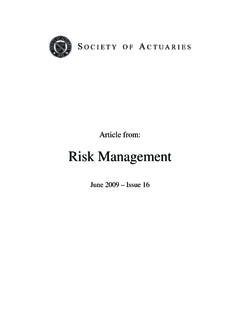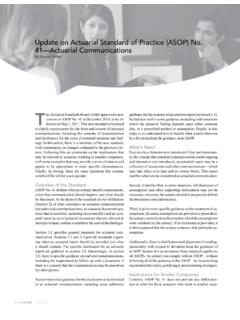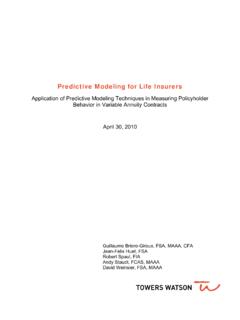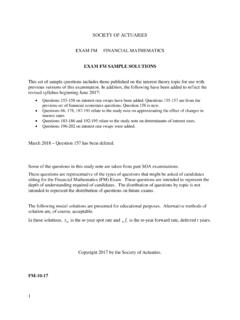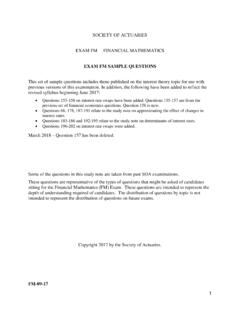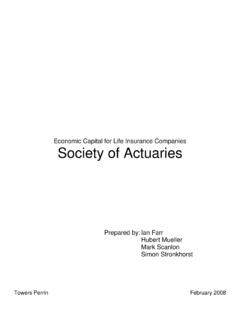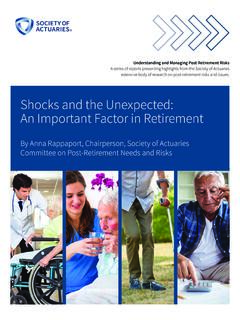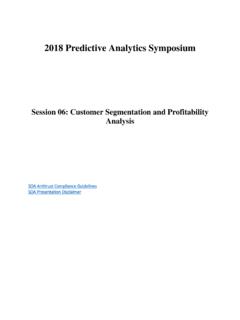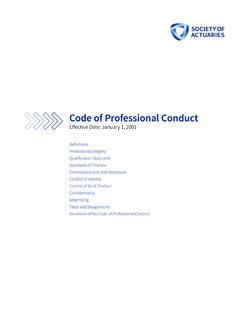Transcription of Mortality Improvement Survey Report - SOA
1 Report of the Society of Actuaries Mortality Improvement Survey Subcommittee March 2003 Society of Actuaries 475 N. Martingale Rd., Ste. 800 Schaumburg, IL 60173 Phone: 847-706-3500 Fax: 847-706-3599 Web site: Copyright 2003 by the Society of Actuaries All rights reserved by the Society of Actuaries. Permission is granted to make brief excerpts for a published review. Permission is also granted to make limited numbers of copies of items in this issue for personal, internal, classroom or other instructional use on the condition that the foregoing copyright notice is used so as to give reasonable notice of the Society s copyright. This consent for free limited copying without prior consent of the Society does not extend to making copies for general distribution, for advertising or promotional purposes, for inclusion in new collective works or for resale. 2 Table of Contents Results of the Mortality Improvement Definition of Chart 1 Underlying Mortality Table 1 Types of Chart 2 Frequency of Mortality Assumption Generational and Durational Mortality Table 2 Use of Generational and/or Durational Mortality Table 3 Applications Where Mortality Improvement Is Table 4 Products Where Mortality Improvement Is Table 5 Factors by which Mortality Improvement Table 6 Basis for Mortality Improvement Table 7 Methodology Used to Develop Mortality Improvement Table 8a - Reasons Generational Improvement Was Not Table 8b Reasons Durational Improvement Was Not Generational Mortality Table 9 Generational Mortality Improvement Durational Mortality Table 10 Application of Mortality Improvement Table 11 Calculation of Durational Improvement Table 12 Durational Improvement Table 13 Primary Decision-Maker for Using Durational Table 14 Who Provides Input into the
2 Development of Durational Table 15 Conceptual Justification for Using Durational Mortality Table 16 Most Significant Conceptual Justification for Using Durational Mortality Table 17 Sources of Data to Decide on Appropriate Future Mortality Personal Table 18 Who Respondents Believe Use Mortality Improvement in Table 19 Personal Beliefs in Using Mortality Chart 3 - Total Mortality Improvement , Underwriting Improvement and Secular Table 20 Historic Mortality Studies Represent an Indication of Future Trends in Table 21 Future Medical Advances to Keep Mortality Improving at a Similar or Better Appendix A Companies Participating in Mortality Improvement 3 introduction The attached Report presents the results of a Survey whose purpose was to explore life insurance company practices regarding the use of a Mortality Improvement assumption in the pricing of life insurance products. The Survey distinguished between updating base Mortality tables for historical Mortality Improvement versus projecting Mortality Improvement into the future.
3 The Survey was conducted by the Mortality Improvement Subcommittee of the Society of Actuaries Life Insurance Mortality and Underwriting Survey Committee. The Survey was based on life insurance company practices in effect during the summer of 2000. Sixty-seven companies responded to our Survey . A complete list of respondents is shown in Appendix A. The Survey contained five sections. Since some of the questions were contingent upon the response to a prior question, some companies did not answer all of the questions. Companies also may not have answered all of the questions because they chose not to answer some of the questions. Percentage results are shown based on the total number of companies who responded to each specific question, unless otherwise noted. Percentages may not add to 100% in some cases due to rounding or where the question allowed the Respondents to check all that apply. The Subcommittee would like to thank all of the companies who took the time to complete the Survey .
4 We would also like to thank the staff of the Society of Actuaries, in particular, Korrel Crawford and Jack Luff, for their invaluable help in facilitating our meetings to develop the Survey and analyze the results and for arranging to have the Survey posted on the SoA web site. We have provided insight where we felt we could; however, our main goal was to present the results in an easy to use format. We hope that you find the results of our Survey both interesting and helpful. We welcome comments and feedback on the content of the Report so that the next Survey can be even more valuable to you. Please send your comments to Jack Luff at the Society of Actuaries. Mortality Improvement Subcommittee of The Society of Actuaries Life Insurance Mortality and Underwriting Survey Committee: Allen R. Pierce, Chair Mary Bahna-Nolan Connie Dewar A. Grant Hemphill Nancy W. Winings David N. Wylde Jack A. Luff, SoA Staff Liaison 4 Mortality Improvement Survey Results of the Mortality Improvement Survey introduction One of the most important parts of the life insurance product development process is deciding upon the appropriate Mortality assumption to use in the pricing.
5 In developing these assumptions, actuaries often use a wide variety of sources, which may include their own company s historical experience, Society of Actuaries Intercompany Studies, their reinsurers experience, studies from the medical community, and professional judgment. An integral part of this process is looking at historical Mortality experience and deciding (1) how to apply it to the current pricing era and (2) how to project the current Mortality into the future. The purpose of this Mortality Improvement Survey Report is not to show what, if any, is the appropriate method for setting Mortality assumptions. Rather, it is to inform the life insurance industry of the various methods that companies currently use to factor Mortality Improvement into the development of their pricing assumptions. Professional reinsurers were not asked to participate in the Survey , except for those companies that perform product development duties for their clients.
6 A separate Survey specifically addressing reinsurance pricing may be sent to the reinsurance community at a later date. Definition of Terms As you read this Survey Report , you will notice that it discusses two types of Mortality Improvement . These are referred to as Generational Improvement and Durational Improvement . While these two types of Improvement differ in their application, their combined effect is to bring historical Mortality experience up to the present time and then to extend these historical trends into the future. Generational Improvement : Describes the process of bringing historical Mortality experience up to the current era. If an actuary has an experience study from an observation period ending several years ago, he or she might want to trend that experience to account for any Mortality Improvement that has occurred from the observation period to the current projection date. Translation of these trends for use in new product pricing might take the form of an entire array of values varying by (for example) gender, underwriting class and issue amount.
7 Durational Improvement : Describes the process of projecting the current era s Mortality into the future. As a cohort proceeds in time from policy year to policy year, the Mortality rates in each year may be lower than the table that was used in the original pricing. Future lower Mortality might be indicated by medical advances in the treatment of diseases, continued research into the factors affecting the aging process and the general trend toward healthier lifestyles. Durational Improvement may be thought of as a way of keeping the annual Mortality rate of a cohort up-to-date with future trends or expectations. Background 67 companies responded to the Survey . All 67 indicated they represented a direct writing insurance company. 91% of these did business in the and 9% of these did business in Canada. The Survey asked respondents to indicate the underlying table used for Mortality assumptions. All 67 companies answered this question.
8 Companies were allowed to choose more than one response. Chart 1 shows that 39% used the SoA 1975-80 Select & Ultimate Basic Tables as one of the underlying tables for Mortality assumptions; 22% cited their own company s Mortality experience as an underlying Mortality table. 5 The 4% for the CIA 1986-92 was relatively small. We suspect this was due to the small number of Canadian respondents. Chart 1 Underlying Mortality Table (Percent of Total Responses) SOA 75-8039%Own Table22%Other13%Tillinghast9%SOA 85-908%Bragg5%CIA 86-924% Write-in responses were placed in the other category. They included: 79-81 US Population (2 responses); SoA 1975-80 Ultimate Basic modified by my company s experience; Our company s experience is analyzed in relation to the industry table; Lincoln Mortality System; A modification of the 75-80 tables; 1997 Lewis & Ellis Select & Ultimate; 1980 CSO; SoA 90-95 was used in our study this year; Bailey (a third-party consultant) Select/Ultimate smoker differentiated tables; CIA 82-88 adjusted for our company s experience; and We also subscribe to Bragg and do comparisons, but don t use it for construction we have used Tillinghast tables in the recent past also, have gone away from them.
9 The Survey asked what type of products were priced or developed in the last 5 years. All 67 companies responded to this question. 84% of the respondents priced or developed a term product. 70% of the companies priced universal life, while 60% priced a whole life product. Less frequently priced products were joint second-to-die, joint first-to-die and variable life. Table 1 summarizes the results. 6 Table 1 Types of Products Priced or Developed in the Last Five Years Response Percentage of Respondents Term Insurance 84% Universal Life 70% Whole Life 60% Joint Second-to-Die 48% Variable Life 40% Joint First-to-Die 22% Other 12% Number of Respondents 67 Other products priced/developed included: Modified Whole Life Guaranteed Issue; Group Term Life; Current Assumption Whole Life; Prepaid Funeral; Senior Final Expense Whole Life and Worksite Universal Life; and Critical Illness. The Survey asked how often the Mortality assumptions were reviewed.
10 66 companies responded to this question. 70% of the respondents indicated that they review their Mortality assumptions annually. Only 4% of the respondents indicated that Mortality assumptions were reviewed more than once per year. The remaining companies responded that Mortality assumptions were reviewed either every 2 to 3 years (12%), every 3 to 5 years (8%) or at the time of product pricing (6%). Chart 2 displays the results. Chart 2 Frequency of Mortality Assumption Review Annually70%2-3 Years12%3-5 Years8%Pricing6%More than Once per Year4% Generational and Durational Mortality Improvement The Survey asked two separate questions with respect to company use of generational and durational Mortality Improvement . There were 67 responses for each question. 35% of the respondents indicated that generational Mortality Improvement was used by their company. 19% used only generational Improvement . In contrast, 25% indicated that durational Mortality Improvement was used by their company.
